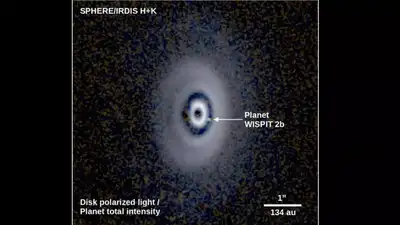ARTICLE AD BOX

Astronomers have made a groundbreaking discovery that could change how we understand the
birth of planets
. Using the European Southern Observatory’s
Very Large Telescope
(VLT) in Chile, researchers have found a young planet, named
WISPIT 2b
, orbiting a star around 430 light years away. What makes this so special is that the planet sits inside a multi-ringed
protoplanetary disk
– a dusty, gas-filled structure where planets form. This is the first confirmed detection of its kind, and it offers scientists a rare glimpse into how planetary systems, including our own solar system, may have developed billions of years ago. The team’s research was published across two papers in The Astrophysical Journal Letters.
About the young planet five times bigger than Jupiter: WISPIT 2b
WISPIT 2b is a gas giant planet, thought to be about the size of Jupiter but much younger – only 5 million years old. In cosmic terms, that makes it an infant compared to Earth’s solar system, which is around 4.6 billion years old. Despite its youth, WISPIT 2b is already massive, estimated to be up to five times bigger than Jupiter. Because it is still forming, the planet glows faintly from the heat of its creation, making it visible in infrared light.
How astronomers captured the first images of WISPIT 2b’s multi-ringed disk
Researchers used the Very Large Telescope (VLT) in the Atacama Desert of Chile to capture images of WISPIT 2b. At first, they were only conducting short “snapshot” observations of many young stars, hoping to spot planets. Instead, they noticed a beautiful
multi-ringed disk
around WISPIT 2. Follow-up observations confirmed the glowing presence of WISPIT 2b within one of the disk’s gaps. Later, astronomers from the University of Arizona captured images in visible light, proving that the planet is still actively gathering material.
WISPIT 2b discovery reveals how young planets shape their surroundings
WISPIT 2b was discovered inside a multi-ringed protoplanetary disk – a structure of gas and dust that orbits young stars and serves as the birthplace of planets. While astronomers have observed hundreds of such disks, spotting a planet clearly within one is extremely rare. WISPIT 2b is the first confirmed planet inside a disk with multiple gaps and rings, making it a unique opportunity to study how planets shape and interact with their surroundings.This discovery may also shed light on how our own solar system formed 4.5 billion years ago. The disk around WISPIT 2 spans about 380 times the Earth–Sun distance, with WISPIT 2b carving visible channels through the dust. These features provide scientists with valuable clues about how young planets clear paths in their birth environments, similar to the early processes that shaped Earth, Jupiter, and the other planets in our solar system.
What is a protoplanetary disk
A protoplanetary disk is like a cosmic nursery. It forms when gas and dust left over from star formation gather into a huge, spinning disk. Inside this disk, clumps of material stick together, growing into planets. Many disks show gaps and rings, which suggest planets are forming and pulling material towards themselves. Until recently, most of this was theory. Now, with WISPIT 2b, scientists have direct proof of a young planet at work inside such a disk.
Exoplanets explained: What makes WISPIT 2b so special
Exoplanets
are planets that orbit stars outside our solar system. More than 5,800 exoplanets have been discovered so far, and astronomers believe billions more exist in our galaxy alone. Some exoplanets are rocky like Earth, while others are giant gas worlds like Jupiter. WISPIT 2b is especially valuable because it shows us what planets look like in their earliest stages of growth, something rarely observed until now.
A rare benchmark system: What WISPIT 2b reveals about planets
Astronomers call this system a “benchmark” for
planet formation
studies. WISPIT 2 is similar to our Sun but much younger, making it a perfect test case to compare with how Earth’s solar system evolved. Capturing direct images of such young planets is incredibly challenging, which is why scientists are thrilled. According to the research team, this discovery will guide future studies and may even explain why other planetary systems look so different from our own.Also read | 10 fascinating facts about the Milky Way galaxy



.png)
.png)
.png)
















 21 hours ago
3
21 hours ago
3








 English (US) ·
English (US) ·